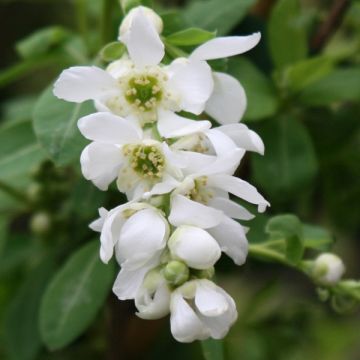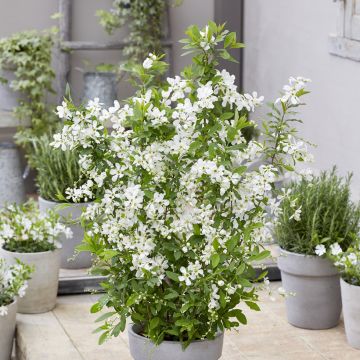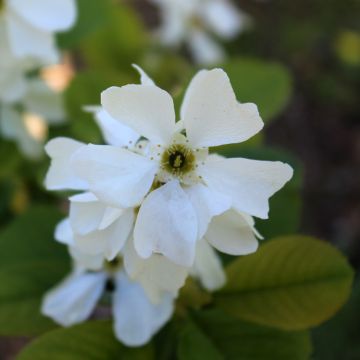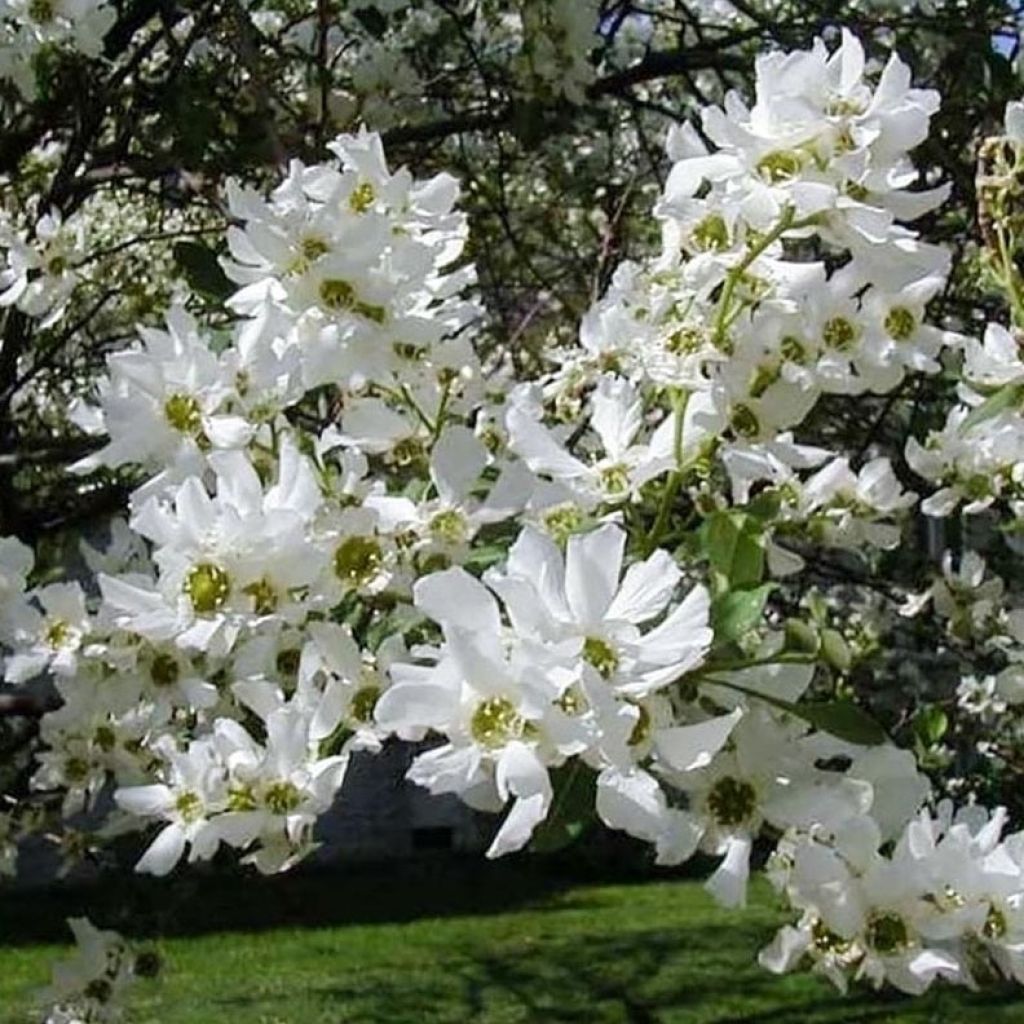

Exochorda serratifolia Snow White
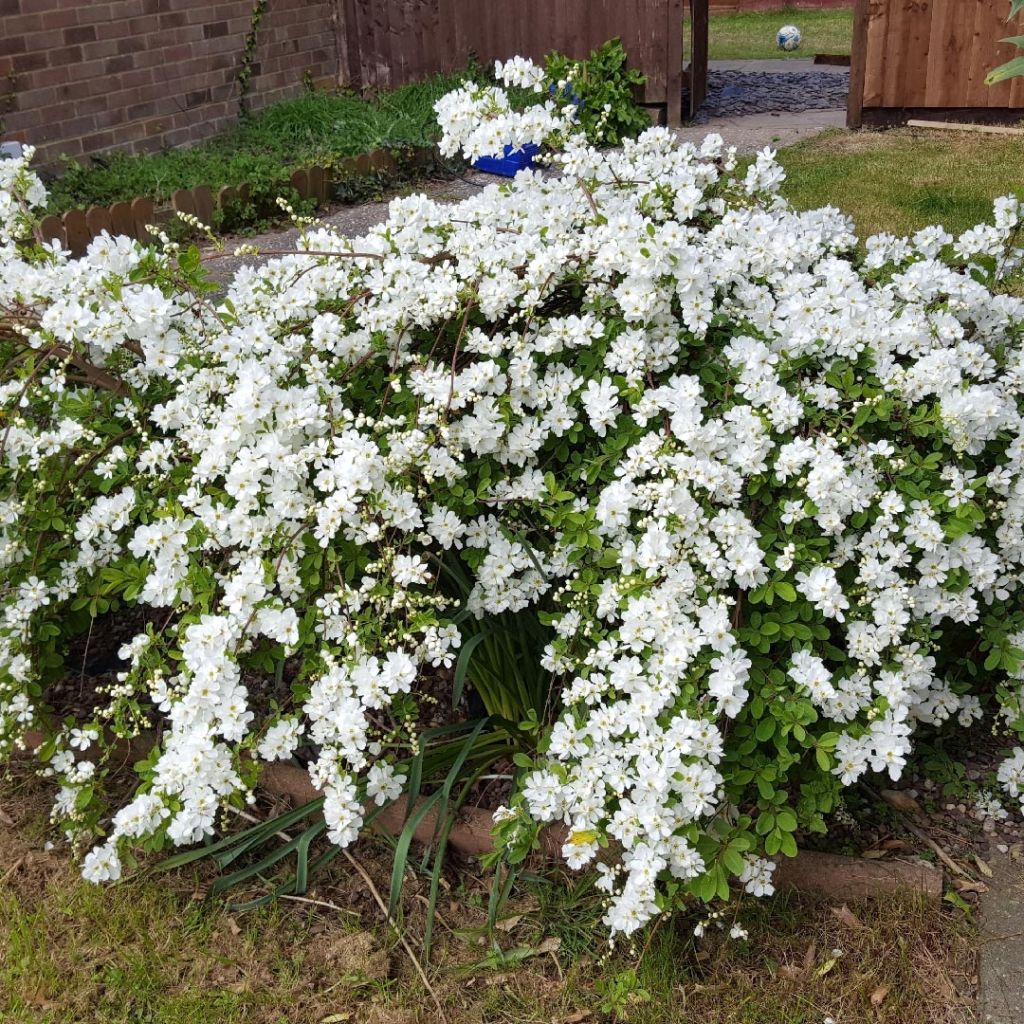

Exochorda serratifolia Snow White
Exochorda serratifolia Snow White
Exochorda serratifolia Snow White
Pearlbush, Common Pearlbush
Why not try an alternative variety in stock?
View all →This plant carries a 24 months recovery warranty
More information
We guarantee the quality of our plants for a full growing cycle, and will replace at our expense any plant that fails to recover under normal climatic and planting conditions.
From €5.90 for pickup delivery and €6.90 for home delivery
Express home delivery from €8.90.
Does this plant fit my garden?
Set up your Plantfit profile →
Description
The Exochorda serratifolia, also known as Snow White, is a unique variety of pearl bushes that stands out due to its denser and more compact growth, which makes it perfect for its massive spring flowering that boasts a dazzling white colour. Apart from its ornamental qualities, this bush is highly adaptable and can grow under various conditions. Unlike other popular cultivars like 'The Bride' or 'Niagara', Snow White can thrive in chalky soils and is more tolerant of summer drought. It's a gracefully opulent bush that is easy to grow. However, after its stunning flowering, it becomes more modest, so it's best to pair it with other bushes or plants with staggered flowering. It's highly recommended to reserve some space in your garden for this beautiful plant.
The Snow White Exochorda serratifolia is a member of the Rose family, and its ancestor originates from Korea and Manchuria. The 'Snow White' variety is a bush with a nicely rounded and dense habit, supported by slightly arched branches. It grows at a moderate pace, reaching an average of 2.50 m (8 ft 2 in) in all directions and sometimes a little more in fertile and fresh soils. Its flowering period is brief but intense, from late March (in the south) to late April to early May. The young branches are covered with a string of perfectly round flower buds, pearly white, which has earned it the nickname "pearl tree". These buds are arranged in clusters of 5 to 10 units and open into single flowers with 5 petals measuring 3-4 cm (1.2-1.6 in) in diameter. They are pure white with a pale yellow centre and so numerous that they almost completely cover the vegetation. The leaves of this deciduous bush emerge in spring, are light to medium green in colour and measure 4 to 5 cm (1.6 to 2 in) long. They are oval, elongated, pointed, and serrated at their tips. The leaves turn yellow before falling in winter. This bush is exceptionally hardy (-20°C (-4 °F)) and has no enemies or diseases in our gardens.
The Snow White Exochorda is an excellent choice for free hedges, solitary planting, and flower beds. It can be accompanied by low-growing plants like Syringa microphylla superba, Abeliophyllum distichum roseum, Chaenomeles speciosa 'Falconnet Charlet', Coronilla glauca Citrina, and Lonicera Tatarica Haack's Red to allow for a spread of spring flowering.
If planted on its own, pair it with perennial plants and bulbs that bloom at the same time, such as Geranium vivace Rozanne, wall bellflowers, bergenia, early tulips, ipheions, or chionodoxas. Alternatively, it can be planted in front of a hedge with dark foliage, conifers, boxwoods, or bay laurels, which will highlight its flowering.
Report an error about the product description
Exochorda serratifolia Snow White in pictures
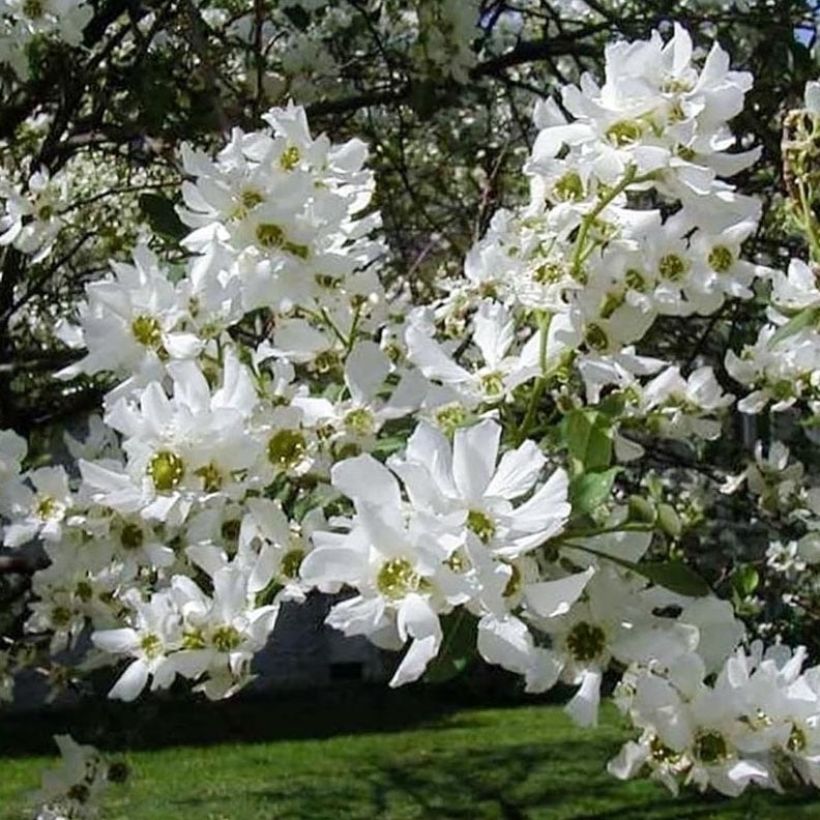

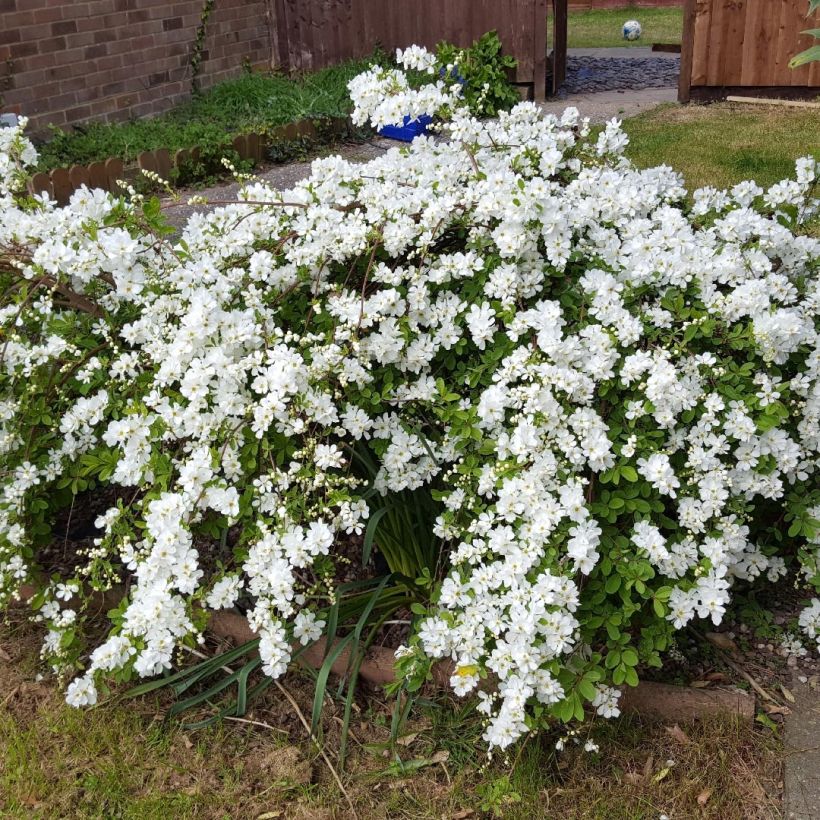

Plant habit
Flowering
Foliage
Botanical data
Exochorda
serratifolia
Snow White
Rosaceae
Pearlbush, Common Pearlbush
Cultivar or hybrid
Other Exochorda
Planting and care
Exochorda 'Snow White' is a beautiful flowering bush that can be planted in full sun or partial shade, especially in hot regions. It can grow in deep and well-loosened ordinary soil, even in limestone and dry soil during summer. Once it is established, the bush does not require watering in most regions.
You can plant Exochorda 'Snow White' in any good and well-worked garden soil. Autumn is the best time to plant it, as it will flower in April-May.
After flowering, you should lightly prune the faded branches to even out the vegetation and remove faded branches. To prevent the bush from becoming bare at the base, you should prune the oldest branches (over 3 years) by a third. This will promote the formation of young stems. Pruning should be carried out every two to three years, while ensuring good airflow in the center of the bush.
Exochorda is not prone to diseases, and its enemies are very few, if not non-existent, in our gardens.
Planting period
Intended location
Care
This item has not been reviewed yet - be the first to leave a review about it.
Haven't found what you were looking for?
Hardiness is the lowest winter temperature a plant can endure without suffering serious damage or even dying. However, hardiness is affected by location (a sheltered area, such as a patio), protection (winter cover) and soil type (hardiness is improved by well-drained soil).

Photo Sharing Terms & Conditions
In order to encourage gardeners to interact and share their experiences, Promesse de fleurs offers various media enabling content to be uploaded onto its Site - in particular via the ‘Photo sharing’ module.
The User agrees to refrain from:
- Posting any content that is illegal, prejudicial, insulting, racist, inciteful to hatred, revisionist, contrary to public decency, that infringes on privacy or on the privacy rights of third parties, in particular the publicity rights of persons and goods, intellectual property rights, or the right to privacy.
- Submitting content on behalf of a third party;
- Impersonate the identity of a third party and/or publish any personal information about a third party;
In general, the User undertakes to refrain from any unethical behaviour.
All Content (in particular text, comments, files, images, photos, videos, creative works, etc.), which may be subject to property or intellectual property rights, image or other private rights, shall remain the property of the User, subject to the limited rights granted by the terms of the licence granted by Promesse de fleurs as stated below. Users are at liberty to publish or not to publish such Content on the Site, notably via the ‘Photo Sharing’ facility, and accept that this Content shall be made public and freely accessible, notably on the Internet.
Users further acknowledge, undertake to have ,and guarantee that they hold all necessary rights and permissions to publish such material on the Site, in particular with regard to the legislation in force pertaining to any privacy, property, intellectual property, image, or contractual rights, or rights of any other nature. By publishing such Content on the Site, Users acknowledge accepting full liability as publishers of the Content within the meaning of the law, and grant Promesse de fleurs, free of charge, an inclusive, worldwide licence for the said Content for the entire duration of its publication, including all reproduction, representation, up/downloading, displaying, performing, transmission, and storage rights.
Users also grant permission for their name to be linked to the Content and accept that this link may not always be made available.
By engaging in posting material, Users consent to their Content becoming automatically accessible on the Internet, in particular on other sites and/or blogs and/or web pages of the Promesse de fleurs site, including in particular social pages and the Promesse de fleurs catalogue.
Users may secure the removal of entrusted content free of charge by issuing a simple request via our contact form.
The flowering period indicated on our website applies to countries and regions located in USDA zone 8 (France, the United Kingdom, Ireland, the Netherlands, etc.)
It will vary according to where you live:
- In zones 9 to 10 (Italy, Spain, Greece, etc.), flowering will occur about 2 to 4 weeks earlier.
- In zones 6 to 7 (Germany, Poland, Slovenia, and lower mountainous regions), flowering will be delayed by 2 to 3 weeks.
- In zone 5 (Central Europe, Scandinavia), blooming will be delayed by 3 to 5 weeks.
In temperate climates, pruning of spring-flowering shrubs (forsythia, spireas, etc.) should be done just after flowering.
Pruning of summer-flowering shrubs (Indian Lilac, Perovskia, etc.) can be done in winter or spring.
In cold regions as well as with frost-sensitive plants, avoid pruning too early when severe frosts may still occur.
The planting period indicated on our website applies to countries and regions located in USDA zone 8 (France, United Kingdom, Ireland, Netherlands).
It will vary according to where you live:
- In Mediterranean zones (Marseille, Madrid, Milan, etc.), autumn and winter are the best planting periods.
- In continental zones (Strasbourg, Munich, Vienna, etc.), delay planting by 2 to 3 weeks in spring and bring it forward by 2 to 4 weeks in autumn.
- In mountainous regions (the Alps, Pyrenees, Carpathians, etc.), it is best to plant in late spring (May-June) or late summer (August-September).
The harvesting period indicated on our website applies to countries and regions in USDA zone 8 (France, England, Ireland, the Netherlands).
In colder areas (Scandinavia, Poland, Austria...) fruit and vegetable harvests are likely to be delayed by 3-4 weeks.
In warmer areas (Italy, Spain, Greece, etc.), harvesting will probably take place earlier, depending on weather conditions.
The sowing periods indicated on our website apply to countries and regions within USDA Zone 8 (France, UK, Ireland, Netherlands).
In colder areas (Scandinavia, Poland, Austria...), delay any outdoor sowing by 3-4 weeks, or sow under glass.
In warmer climes (Italy, Spain, Greece, etc.), bring outdoor sowing forward by a few weeks.


































